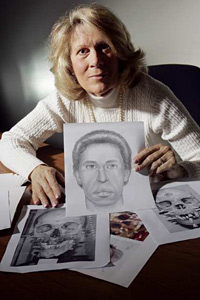 |
 |
 |
 Vallarta Living | Art Talk | January 2006 Vallarta Living | Art Talk | January 2006  
She Gives Bodies Their Faces Back
 Susana Enriquez - LATimes Susana Enriquez - LATimes


| | Starting With A Skeleton: Thats what Marilyn Droz had to work with when reconstructing this face. She studies available evidence to establish features such as hairline and build. (Don Kelsen/LAT) |
Marilyn Droz draws dead people.

During her three hours with a corpse, she looks at the hair follicles to help her establish a missing hairline. She analyzes clothing to help determine the person's build. She pulls out a ruler and measures the distance between the eyes, nose and mouth. She peels back the eyelids and lips to see the eyes and teeth.

"They're like putting complicated puzzles together," said Droz, 59.

Droz is the person the coroners in Los Angeles and Orange counties turn to when they can't identify a body. Through her sketches, she erases injuries and decomposition.

"You need something that looks alive, that isn't going to be disturbing to the family when they see the person in the newspaper," Droz said. "Putting up the actual picture of someone [dead] is going to be more disturbing to a loved one, as opposed to a portrait."

The Huntington Beach resident is among a handful of artists who work for law enforcement agencies around the country drawing bodies, said Karen Taylor, a forensic art instructor at the FBI Academy in Virginia who has sketched thousands of John and Jane Does.

Droz works mostly with the LAPD and several Orange County police departments drawing composite sketches of criminals. Postmortem drawing is a niche within the field of forensic art that requires an understanding of anatomy, Taylor said.

Although some agencies release photographs of the deceased, others consider the practice taboo.

"It seems to us to be more dignified to do it in a hand drawing," said Bruce Lyle, Orange County's assistant chief deputy coroner. "If we have a better option, why not use it? Why push the issue?"

Lyle said counties interpreted the laws that govern the release of coroner photos differently.

In Orange County, the coroner releases photos only for trials and teaching forensics. The coroner's website has nearly 50 John and Jane Does dating from 1970, 16 of which were drawn by Droz.

A sketch depicting how a person may have looked is helpful, Lyle said, because the Doe may not be recognizable because of injuries, exposure to extreme temperatures, decomposition or scavenging insects or animals.

If the person is missing a nose, Lyle said, Droz can draw one, based on other features. To keep a corpse's odor at bay, she dabs medicated ointment below her nostrils.

The Los Angeles County coroner's office, which has hundreds of Does on its website, posts photographs unless the person was shot in the head or the body is extremely decomposed, said coroner's investigator Gilda Tolbert.

In those situations, the agency posts descriptions of the person's clothing, jewelry and tattoos, or they call Droz, who has helped in the identification of several of the county's Does.

This week, Droz got a message from Tolbert saying a John Doe she had sketched in July had been identified. In that case, Droz reconstructed the face of the teenage boy, whose skeleton was found in the chimney of a vacant South Los Angeles building in March.

A woman who saw the drawing called and said the boy resembled her nephew, who had been missing since 1977. DNA testing proved it was him.

"It's amazing how close she gets," Tolbert said. "She's good."

Droz sketched her first John Doe in 1981, a man who had been shot with a hunting arrow in Huntington Beach. "I'm sure I was terrified," she said.

In the years that followed, she drew a John Doe who was found in a plastic bag floating in a pond and another who was burned after he was killed. Because she was able to see past the swollen and charred faces of the men and sketch something remarkably close to what they looked like before they died, both were identified.

"It feels good when you know you helped a family have closure," Droz said. A few years ago, the family of a Brea man asked for her drawing as a keepsake.

Although her work with the dead has diminished because of the advent of a statewide automated identification system that stores criminals' fingerprints, Droz still sketches about five per year.

Many Does, she said, remain unidentified because they are transients from out of state or undocumented immigrants.

A recent subject was Orange County's latest John Doe.

In October, the Asian man, estimated to be 16 to 29 years old, was killed when hit by a car on Pacific Coast Highway in Huntington Beach.

As she reviewed her sketch months later, she realized she had accidentally drawn him with a lazy eye.

"It looked right to me when I was doing it," she said. "You can get so intent on getting the bone structure and the hairline right and then mess up on something simple, like centering the eye." | 
 | |
 |



